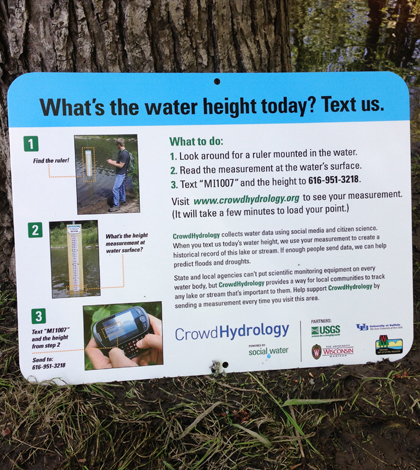CrowdHydrology sources water level data from public’s text messages

Chris Lowry’s idea was simple: set up staff gauges on local streams and leave a sign requesting passersby read the water level and text the data to a phone number. Data from text messages would be recorded and then posted to a website for public use.
It was the beginning of CrowdHydrology, a crowdsourcing project that recently gained U.S. Geological Survey support for expansion into several Midwest states. Though it won’t generate as much data as official USGS stream gauges, the project will generate data points that supplement those lost from official gauges shut down following federal budget cuts.
Lowry, an assistant professor of geology at the University at Buffalo, set up eight pilot sites in New York in 2011 in an attempt to crowdsource water level data. Each used a staff gauge, laminated sign and phone numbers set up through Google Voice.
“I had some students who needed to know water levels for an area. I started to look at different mechanisms for support and I thought, ‘If there are some applications to do it in other locations, why can’t I do it in mine?’” said Lowry. “I bought a ruler, tested it out and people just started texting me.”
The texts received were routed to Google email addresses that Lowry checked manually, posting data to a web portal on his own. That is, until he ran into Mike Fienen at a conference in Minneapolis.
“I was interested and thought it had lots of potential, but Chris was doing a lot of work by hand,” said Fienen, a research hydrologist with the USGS Wisconsin Water Science Center.
Fienen and Lowry discussed programming that might simplify processing data coming from texts, which was the birth of Social.Water, a software program to automate the process.
But making a program to read emails isn’t as simple as it sounds. Texts are written in different ways. Some people may spell out “feet,” while others write “ft.” Messages sometimes contain extra spaces or station identification numbers are mistyped. Auto-correct software on smartphones can alter state abbreviations, e.g. NY becomes MY, making a station designation of “MY1000” useless.
“The interesting challenge with the software is figuring out what messages mean,” said Fienen. “We use a fuzzy search to see what’s in the message.”
So if a station identifier doesn’t match, then the message containing it is automatically thrown out. If a spam message comes into one of the email accounts, it’s disregarded.
“The software logs in, checks for messages and figures out which gauge data is for,” said Fienen. “It finds the data point, updates and posts a graph to the web.”

Staff gauges at CrowdHyrdology sites feature a station identifier and a phone number to receive text messages. (Credit: Chris Lowry)
Lowry called Social.Water the “brains behind processing” the messages. The software is built on an open-source platform so anyone may use it. That fits the open nature of the entire CrowdHydrology project, which is in the midst of adding its new sites: 10 more in New York State, 20 each in Michigan and Wisconsin and three in Iowa.
The new sites, which now use specially designed metal signs, may help supplement data lost from USGS stream gauges that were shut down following federal budget cuts. Fienen and Lowry are quick to point out that the staff gauges are not a replacement for the highly automated, real-time monitoring stations that sometimes report data every 15 minutes.
“It (CrowdHydrology) gives us an idea of the water levels in streams. It gives us a fuzzy look, a data point we didn’t have before. So, for example, if you’re interested in fly fishing – log on and check it out so you can see if it’s worth the trip,” said Lowry.
The staff gauges are a great way to get passersby interested in monitoring water levels. The barrier of entry is low – every cell phone can send a text message and most people in the U.S. have one. Lowry envisions parents taking their kids to a park, coming across one of the gauges and showing their kids the process. It’s an easy way to spark interest, he says. He’d also like to use the program to get K-12 students interested in water monitoring and plans to make kits that school teachers can use to set up their own sites.
The program also has potential in other locations around the world.
“One of my hopes is that it could expand into other countries without available data like in the U.S.,” said Fienen. “To create a citizen-driven flood monitoring network in places where there aren’t official data. That’s where I could see this having the most impact.”
Top image: Signs at CrowdHydrology gauges instruct passersby to text water level data. (Credit: Chris Lowry)




Matthew Mabey
September 26, 2013 at 6:18 pm
It seems that they should also be asking that photos of the staff gauge be sent in so that they could check the accuracy of the general public’s reading of the gauge.